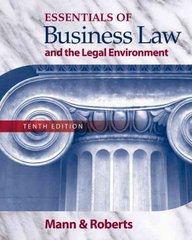Question
Suppose that a toll bridge can use toll-booth operators L or ez-pass machines K to collect tolls. Given L labor-hours and K ez-pass machines, the
Suppose that a toll bridge can use toll-booth operators L or ez-pass machines K to collect tolls. Given L labor-hours and K ez-pass machines, the bridge can collect tolls q equal to:
q=(L + 50K)^(1/2)
A) Placing labor on the horizontal axis and capital on the vertical axis, draw an isoquant representing the combinations of capital (ez-pass machines) and labor (toll-booth operators) that can collect 10 tolls. Draw another isoquant representing the combinations of capital and labor that can collect 20 tolls.
B) Does this production function exhibit increasing, decreasing, or constant returns to scale?
C) What is the MRTS of capital for labor? Verbally describe the relationship between ez pass machines and toll-booth operators in production.
D) Suppose W=10 and R=1,000. What is the lowest cost way of collecting 10 tolls?
E) Suppose W=10 and R=100. What is the lowest cost way of collecting 20 tolls?
F) If the toll bridge faces general input prices W and R, what is the cheapest way to collect q tolls? Write down a cost function in terms of q, W, and R: C(q,W,R).
Step by Step Solution
There are 3 Steps involved in it
Step: 1

Get Instant Access to Expert-Tailored Solutions
See step-by-step solutions with expert insights and AI powered tools for academic success
Step: 2

Step: 3

Ace Your Homework with AI
Get the answers you need in no time with our AI-driven, step-by-step assistance
Get Started


